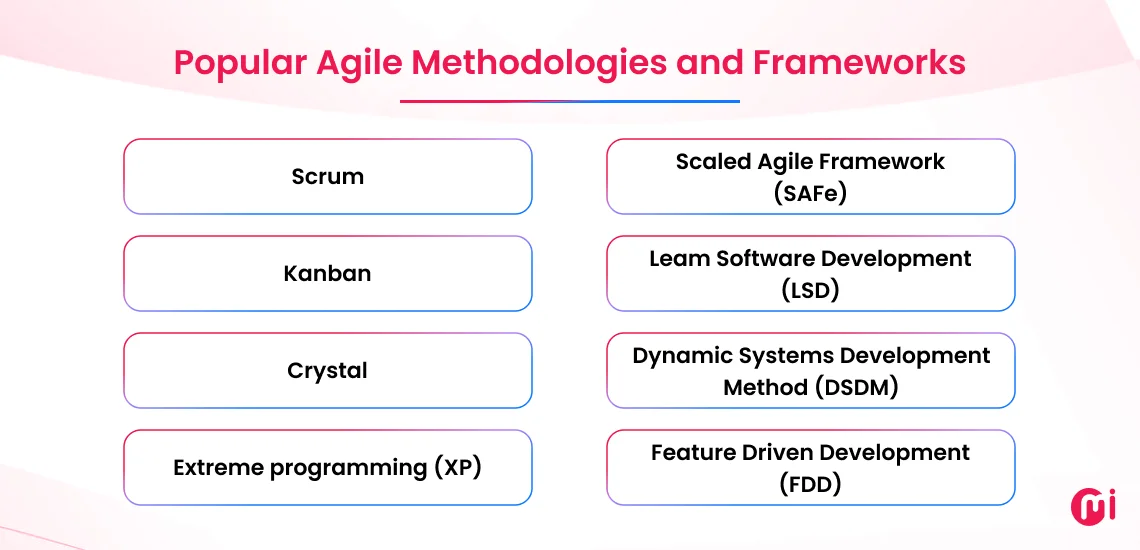How Agile Software Development Empowers Enterprises to Scale and Innovate
- Software
- January 6, 2025
Agile adoption can lead to a 64% improvement in software delivery, a 45% enhancement in software quality, a 51% boost in delivery predictability, and a 49% increase in customer satisfaction—and that’s just the beginning. If you’re seeking similar improvements in your software development process, Agile is the way forward. This blog on Agile Software Development offers valuable insights into Agile Software, covering methodologies, principles, benefits, and more.
Change is inevitable; why resist it?
Even in software development. Agile is the best foot forward to deal with this resistance.
Agile isn’t just about speed; it’s about delivering value.
In Agile software development, teams don’t follow a strict, linear path to project completion. Instead, they work in iterations, short cycles of development, where they develop working software, gather feedback from users, and then adapt the agile software based on the feedback.
By adopting agile software development, organizations do not merely follow a methodology—they embrace a new way of thinking about development, one that values flexibility, responsiveness, and continuous improvement.
Let’s learn more about the fundamentals of Agile software development in this blog.

What is Agile Software Development?
Agile software development is a software development methodology that emphasizes flexibility, collaboration, and customer feedback. It values working software over comprehensive documentation, and iterative progress over a rigid, step-by-step software development process.
This is in contrast to the traditional software development approach, such as Waterfall, in which larger projects are planned upfront and teams must stick to the original plan, leaving no room to meet the demands of rapid technological advancements and evolving customer needs.
Agile software development, on the other hand, is dynamic and supports a more collaborative approach.
Teams work in short cycles, called iterations or sprints. It drastically shortens the DevOps life cycle. The iterations or sprints are typically two to four weeks long, and at the end of each sprint, teams deliver a working increment of the product. This allows for frequent feedback, quick adjustments, and ensures that the product is always aligned with the customer’s needs.
An ideal Agile software development process involves concept/initialization, requirements gathering (product backlog creation), sprint planning, design and development (sprint execution), testing, review, retrospective, and repetition.
Popular Agile Methodologies and Frameworks
With various methodologies and frameworks available, Agile software development caters to diverse software development needs. Here are some of the most popular Agile software development methodologies and frameworks:

1. Scrum
Scrum is one of the most widely adopted Agile project management frameworks in the world today.
It’s a framework that breaks down complex projects into smaller, manageable chunks called “sprints.” Each sprint typically lasts 2-4 weeks, and during that time, the team focuses on completing a specific set of work items. The goal is to deliver a working product increment at the end of each sprint.
Scrum agile development is a structured yet flexible framework that emphasizes teamwork, accountability, and continuous improvement. It’s all about collaboration, transparency, and delivering value in small, manageable steps.
Key Elements of Scrum:
- Sprints: Time-boxed iterations (usually 2-4 weeks)
- Roles: Product Owner, Scrum Master, Scrum Development Team
- Events: Sprint Planning, Sprint, Daily Scrum or Standup, Sprint Review, and Sprint Retrospective
- Artifacts: Product Backlog, Sprint Backlog, Increment
2. Kanban
Originally created to improve manufacturing efficiency, industrial engineer Taiichi Ohno developed Kanban at Toyota Motor Corporation. Kanban is a Japanese term that literally means “billboard” or “signboard.”
This framework emphasizes the visualization of workflows, allowing teams to get a bird’s-eye view of where their software development projects stand at any point in the defined timeline. This, in turn, helps achieve transparency. It also empowers teams to recognize potential bottlenecks that may affect productivity.
Core Kanban Practices:
- Visualization of workflows through Kanban boards
- Set a work in progress (WIP) limit
- Manage flow using Kanban boards
- Comprehensive process documentation
- Deploy feedback loops
- Measure Continuous improvement
3. Crystal
Created by Alistair Cockburn while working for IBM, Crystal is a family of Agile methodologies tailored to team size, priorities, and project criticality.
The Crystal family includes variants such as Crystal Clear, Crystal Yellow, Crystal Orange, Crystal Orange Web, Crystal Red, Crystal Sapphire, and Crystal Diamond. Each variant is designed to suit different project scales and levels of complexity, from small, low-risk endeavors to large, mission-critical initiatives.
Unlike Scrum, which follows a more structured approach, Crystal emphasizes adaptability and is designed to evolve based on the team’s unique context. It prioritizes human interaction, collaboration, and reflective improvement over rigid processes, allowing teams the flexibility to innovate and deliver value efficiently.
Key Attributes:
- Frequent delivery
- Osmotic communication
- Reflective improvement
- Technical tooling
- Easy access to expert users
4. Extreme programming (XP)
If you believe in leaving no stone unturned, XP might be the perfect agile development framework. Developed by software engineer Kent Beck, XP is a lightweight Agile framework designed to tackle projects with dynamically changing requirements. It emphasizes teamwork, technical excellence, and customer satisfaction, making it ideal for rapidly evolving environments.
The core practices of XP include test-driven development (TDD), pair programming, small releases, refactoring, collective code ownership, on-site customers, continuous integration, and a sustainable pace.
Core values of XP:
- Simplicity
- Communication
- Feedback
- Respect
- Courage
5. Scaled Agile Framework (SAFe)
Want your software to better meet changing customer needs? Scaling Agile? SAFe is the best agile framework for it right now.
It’s a blend of Agile, Lean, and DevOps principles, designed to keep everyone—from C-suite executives to developers—on the same page. As the best framework for scaling Agile delivery, it empowers large organizations to incorporate changing market needs and customer demands without affecting delivery.
The core values of SAFe are alignment, built-in quality, transparency, program execution, and leadership.
SAFe Principles:
- Aiming for the best economic outcome
- Think about the whole system, not just one part
- Expect change and uncertainty; keep your options open
- Break work into smaller pieces and deliver them; learn along the way
- Base milestones on objective evaluation of working systems
- Keep track of what’s being worked on and limit how much work is in progress at any time
- Create a regular rhythm for work (like weekly or bi-weekly cycles)
- Give your team the freedom to make decisions
- Decentralize decision-making
5. Lean Software Development (LSD)
Think of Lean as the Marie Kondo of software development—it helps you eliminate waste and focus on what truly adds value. Like other frameworks inspired by the manufacturing industry, Lean Software Development (LSD) draws from the practices invented by Toyota to streamline car production, reduce wasted time, and optimize resources.
LSD or Lean Software Development empowers teams to make quick decisions, pivot when necessary, and deliver value faster.
LSD Principles:
- Eliminating the waste
- Fast delivery
- Amplify learning
- Build quality
- Respect teamwork
- Delay the commitment
- Optimizing the whole system
6. Feature Driven Development (FDD)
It is an Agile methodology that focuses on delivering features in a systematic, customer-centric, and incremental way. By adopting FDD, you can achieve predictability in your software project.
With FDD, you can stay on track, deliver value quickly, and keep the focus on what matters most to the customer—features that truly make a difference. If you need a clear, feature-focused approach to delivering software, FDD could be the perfect fit.
FDD Process Flow:
- Develop an overall model
- Build a features list
- Plan by feature
- Design by feature
- Build by feature
7. Dynamic Systems Development Method (DSDM)
Originating in the 90s, DSDM is one of the older Agile software development methods. It places a strong emphasis on collaboration, flexibility, and active user involvement throughout the project lifecycle.
Rooted in Agile principles, DSDM focuses on working closely with business stakeholders to ensure the solution aligns with business goals and delivers value throughout the software development process.
DSDM Principles:
- Focus on the business need
- Deliver on time
- Collaborate
- Never compromise quality
- Build incrementally from firm foundations
- Develop iteratively
- Communicate continuously and clearly
- Demonstrate control

12 Agile Manifesto Principles
Created by a group of software developers in 2001, this manifesto provided a fresh perspective to software development that prioritized flexibility, customer collaboration, and rapid delivery. The Manifesto is grounded in the following 12 principles that continue to guide Agile practices across industries today.
- Prioritize customer satisfaction through early and continuous delivery of valuable software
- Welcome changing requirements, even late in development to harness customer competitive advantage
- Deliver working software frequently with shorter timescales
- Business stakeholders and developers must work together daily
- Build projects around motivated individuals
- The most effective method of communication is face-to-face
- Working software is the primary measure of progress
- Maintain a sustainable pace of work
- Continuous attention to technical excellence
- Simplicity is essential
- Self-organizing teams produce the best results
- At regular intervals, the team reflects on how to improve
These principles are the foundation of many popular Agile frameworks like Scrum, Kanban, Extreme Programming (XP), and more.
Key Benefits of Agile Software Development for Enterprise Success
Apart from faster time-to-market, greater flexibility, high adaptability, risk management, continuous improvement, and more, here are some of the most impactful advantages of agile software development:
1. Better Incident Response
There is no denying that things can go off the rails. Downtime, bugs in production, or even a full-blown system failure—such incidents are likely.
With high stakes in sustaining customer satisfaction and keeping reputation intact, adopting agile software development methodologies and frameworks are of great help. It allows teams a structured and iterative approach to project management when responding to the required changes in such incidents.
2. High-Velocity Development Teams
Velocity implicitly reflects a team’s efficiency. The Agile metric, velocity, measures the work completed by a Scrum team during sprints. It empowers the following:
- Predictability when planning
- Better resource allocation
- Increases sense of accomplishment
- Greater customer satisfaction
- Accuracy in forecasts
- Consistency in performance
- Better communication and collaboration
Here’s what these benefits translate into:
- 45% enhanced software quality
- 60% increased team productivity
- 64% accelerated software delivery
- 51% enhanced predictability of software delivery
- 45% increased process discipline
| Quick Tip! Just as every team’s productivity is different, so will their velocity. Resist comparing velocity across teams; instead, focus on measuring the quality of their outputs. |
3. More Effective Scope Creep Handling
Given the dynamic nature of market conditions, user feedback, and evolving understanding of the original project, it is possible for work to arise that is not part of the agreed-upon epics or releases. This can manifest as delays, budget overruns, and misaligned deliverables.
Agile software development provides greater control over how scope creep is managed. Regular communication ensures that shifts in project scope are identified and addressed early. Agile helps teams focus on what truly matters with a well-prioritized product backlog. Above all, the iterative nature of the development process empowers teams to prevent scope changes from disrupting the current work.
Agile Software Development: The MindInventory Advantage
As a leading software development company, MindInventory understands that businesses need more than just functionality—they need solutions that drive real value.
While the end goal of creating a functional product is important, we believe that the process of development is just as crucial. Each step of the way is an opportunity to learn, refine, and improve.
We don’t rush to the finish line. Instead, we embrace each iteration as a moment of discovery—finding better ways to solve problems, enhance user experience, and create software that meets your unique needs.
With our experience in Agile, our software developers for hire assisted one of the largest fast-food restaurant chains in the United States and partnered with us to develop a country-specific order management system for its outlets.
The result?
Over 10 million downloads, a 30% increase in efficiency, and 75% fewer order errors. Our tailored solutions helped streamline operations and improve customer satisfaction, setting the stage for future growth. This is just one example.
With our expertise, commitment to quality, and customer-first approach, we are the ideal software product development company for your projects. Let’s work together to bring your ideas to life and create software that drives growth, efficiency, and success.
FAQs on Agile Software Development
Agile and DevOps serve different purposes, so neither is inherently “better” than the other. Agile is best for managing development processes with flexibility and iterative progress, while DevOps focuses on automating and streamlining deployment and operations. When combined, they optimize the entire software development lifecycle, improving both development speed and operational efficiency.
Only when it is poorly applied or if teams do not follow Agile principles effectively it becomes inefficient. Otherwise, it is designed to better adapt to the changing needs of customers early on, saving time and effort on a complete overhaul later.
There is a misconception circulating that Agile and large organizations do not go well together. The reasons often cited to support this misconception include the difficulty in collaboration (a key aspect of Agile) within large teams and the potential loss of flexibility due to the introduction of structure and methods that may not align with the Agile approach. That being said, it is possible to scale Agile principles for large organizations.
Well, the beauty of Agile is that it enables you to adjust your resource allocation if any interruptions occur. This way, you can address the issues without sidetracking the development.
No, it can’t be an excuse for the lack of a roadmap. Without a roadmap, your team will find themselves pivoting in a new direction with every sprint, even if they know what they are doing or planning to achieve due to the adoption of the Agile approach.
The Agile metrics to track when optimizing software delivery include sprint burndown, epic and release burndown, velocity, control charts, cumulative flow diagrams, and more.













